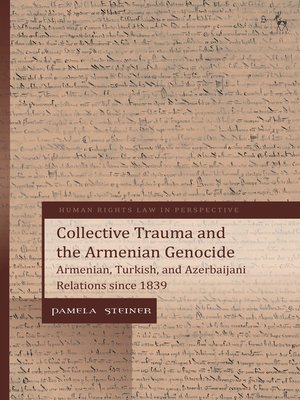Collective Trauma and the Armenian Genocide
ebook ∣ Armenian, Turkish, and Azerbaijani Relations since 1839 · Human Rights Law in Perspective
By Pamela Steiner

Sign up to save your library
With an OverDrive account, you can save your favorite libraries for at-a-glance information about availability. Find out more about OverDrive accounts.
Find this title in Libby, the library reading app by OverDrive.



Search for a digital library with this title
Title found at these libraries:
| Library Name | Distance |
|---|---|
| Loading... |
In this pathbreaking study, Pamela Steiner deconstructs the psychological obstacles that have prevented peaceful settlements to longstanding issues.
The book re-examines more than 100 years of destructive ethno-religious relations among Armenians, Turks, and Azerbaijanis through the novel lens of collective trauma.
The author argues that a focus on embedded, transgenerational collective trauma is essential to achieving more trusting, productive, and stable relationships in this and similar contexts. The book takes a deep dive into history - analysing the traumatic events, examining and positing how they motivated the actions of key players (both victims and perpetrators), and revealing how profoundly these traumas continue to manifest today among the three peoples, stymying healing and inhibiting achievement of a basis for positive change.
The author then proposes a bold new approach to "conflict resolution" as a complement to other perspectives, such as power-based analyses and international human rights. Addressing the psychological core of the conflict, the author argues that a focus on embedded collective trauma is essential in this and similar arenas.
The book re-examines more than 100 years of destructive ethno-religious relations among Armenians, Turks, and Azerbaijanis through the novel lens of collective trauma.
The author argues that a focus on embedded, transgenerational collective trauma is essential to achieving more trusting, productive, and stable relationships in this and similar contexts. The book takes a deep dive into history - analysing the traumatic events, examining and positing how they motivated the actions of key players (both victims and perpetrators), and revealing how profoundly these traumas continue to manifest today among the three peoples, stymying healing and inhibiting achievement of a basis for positive change.
The author then proposes a bold new approach to "conflict resolution" as a complement to other perspectives, such as power-based analyses and international human rights. Addressing the psychological core of the conflict, the author argues that a focus on embedded collective trauma is essential in this and similar arenas.







